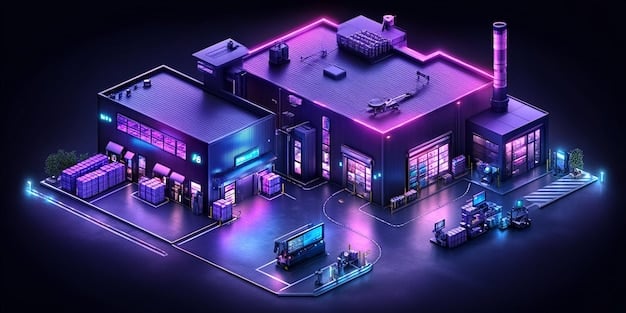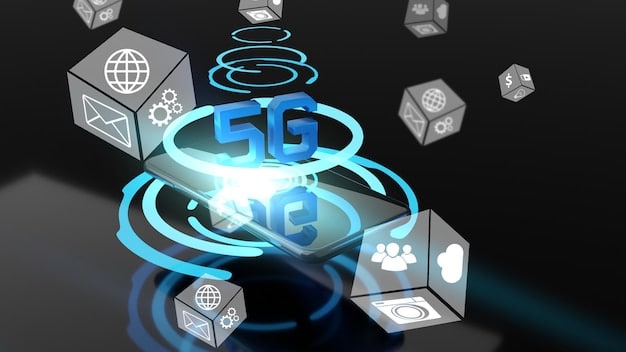5G Network Slicing to Revolutionize US Mobile Experiences by 2025

By 2025, 5G network slicing will revolutionize US mobile experiences by enabling customized, dedicated virtual networks for specific applications and users, ensuring unparalleled performance and reliability for diverse demands.
The dawn of the 5G era promises not just faster speeds but a fundamental reimagining of mobile connectivity. Central to this transformation is 5G network slicing, a groundbreaking technology set to redefine how Americans interact with their mobile devices and the digital world. This innovation goes beyond simple bandwidth upgrades, paving the way for a highly personalized and efficient network landscape.
Understanding the Core of 5G Network Slicing
At its heart, 5G network slicing is akin to having multiple virtual networks running on a single physical 5G infrastructure. Instead of a one-size-fits-all approach, this technology allows telecommunication companies to create dedicated, isolated network “slices,” each optimized for specific services, applications, or user groups. This level of customization ensures that critical operations receive the resources they need without interference from less demanding traffic.
This paradigm shift is driven by the intrinsic capabilities of 5G, particularly its software-defined networking (SDN) and network function virtualization (NFV) components. These technologies allow network resources—such as bandwidth, latency, and data processing—to be dynamically allocated and managed in real-time, moving away from traditional, rigid hardware-based architectures.
The Technical Foundation: SDN and NFV
Understanding the interplay between SDN and NFV is crucial to grasping network slicing’s power. SDN separates the network’s control plane from its data plane, providing a centralized view and programmable control over network resources. NFV, on the other hand, virtualizes network services that traditionally ran on proprietary hardware appliances, allowing them to run on standard servers.
- Software-Defined Networking (SDN): Centralizes network control, allowing for programmable and dynamic resource allocation.
- Network Function Virtualization (NFV): Converts hardware-based network functions into software, enabling flexible deployment and scalability.
- Orchestration: Sophisticated software platforms manage and coordinate the creation, deployment, and management of these slices automatically.
Together, these elements empower carriers to provision slices on demand, tailoring each one to a unique set of requirements. This means distinct quality of service (QoS) guarantees can be made for each slice, ensuring that an autonomous vehicle fleet doesn’t compete for bandwidth with a casual video streamer.
The ability to isolate and manage resources within these slices is a game-changer. It means that issues in one slice won’t impact the performance of another, significantly enhancing security and reliability across the entire network. This isolation is not just about performance; it’s about creating an impenetrable digital ecosystem for specialized services.
Transforming Consumer Mobile Experiences
For the average US mobile user, 5G network slicing promises a future where their digital interactions are smoother, more reliable, and tailored to their needs. Imagine a seamless gaming experience, crystal-clear video calls, or instantaneous downloads, all guaranteed by a dedicated slice of the network. This goes far beyond what current best-effort mobile networks can offer.
One of the most immediate impacts will be seen in entertainment and communication. With dedicated slices, streaming high-definition video in crowded areas will become lag-free, and multiplayer mobile gaming will finally achieve console-level responsiveness, removing frustrating delays that often plague current mobile connections.
Enhanced Gaming and Media Streaming
Dedicated slices for gaming can offer ultra-low latency and consistent bandwidth, essential for competitive online play. Similarly, high-quality video streaming services can secure a slice that guarantees buffering-free playback, even during peak hours.
- Guaranteed ultra-low latency for competitive mobile gaming.
- Buffer-free 4K/8K video streaming, even in congested areas.
- Immersive augmented reality (AR) and virtual reality (VR) experiences on mobile devices.
This personalization extends to communication. Critical communication services, such as emergency calls or business video conferences, could be allocated a premium slice, ensuring they always get priority and optimal performance regardless of network congestion. This level of service guarantee has been largely aspirational in previous mobile generations.
Furthermore, the rise of sophisticated mobile AR and VR applications will largely depend on the capabilities of network slicing. These applications require immense bandwidth and extremely low latency to deliver an immersive and believable experience. A dedicated AR/VR slice would provide the necessary infrastructure, unlocking a new generation of mobile entertainment and utility.
Empowering Industry Verticals and Enterprise Solutions
Beyond individual consumers, 5G network slicing will unlock unprecedented opportunities for various industries and enterprises across the US By allowing businesses to reserve specific network segments with guaranteed performance characteristics, it creates a robust foundation for mission-critical applications that simply aren’t feasible on shared, best-effort networks. This is where the true economic impact of 5G is expected to materialize.
Consider the manufacturing sector, where smart factories rely on thousands of interconnected sensors and robotic systems. A single network disruption can lead to massive losses. With network slicing, manufacturers can deploy a dedicated slice with ultra-reliable low-latency communication (URLLC) capabilities, ensuring continuous operation and real-time control, even for complex automation tasks.

Revolutionizing Key Sectors
From healthcare to logistics, the potential for customized network solutions is vast. Each sector has unique demands that can be met with tailored slices.
- Smart Manufacturing: Dedicated slices for robotics, IoT sensors, and real-time process control, ensuring operational continuity and efficiency.
- Healthcare: Slices for telemedicine, remote patient monitoring, and connected ambulances, guaranteeing high reliability and data security.
- Logistics and Transportation: Optimized slices for autonomous vehicles, drone delivery, and smart traffic management, requiring ultra-low latency and high bandwidth.
- Public Safety: Priority slices for first responders, ensuring communications remain operational during emergencies and disasters.
The ability to secure specific network parameters like bandwidth, latency, and security for enterprise applications allows companies to innovate and deploy technologies that were previously unachievable. This opens doors for advanced analytics, AI-powered automation, and fully connected ecosystems that can drive unprecedented efficiency and new service models. Enterprises will no longer need to build their own private networks from scratch; they can leverage public 5G infrastructure with private network-like guarantees.
This level of network customization also facilitates multi-tenancy on a single physical infrastructure, meaning different companies can operate their specialized applications without interfering with each other. It’s an economically viable solution for businesses looking to harness advanced 5G capabilities without the prohibitive costs of building and maintaining proprietary hardware.
Security and Reliability Enhancements
The concept of isolation inherent in 5G network slicing naturally leads to significant improvements in security and reliability. Each virtual slice operates as an independent network, effectively segmenting traffic and preventing breaches in one slice from affecting others. This architectural design creates a more resilient and secure digital environment, critical for the sensitive data and operations increasingly relying on mobile connectivity.
In traditional network setups, a security vulnerability or a denial-of-service attack on one application could potentially compromise the entire network. With network slicing, the damage is contained within the compromised slice, protecting other services and users. This compartmentalization is a powerful defence mechanism against cyber threats.
Key Security Advantages
The isolation provided by network slicing offers tailored security protocols and greater resilience against a variety of threats.
- Traffic Isolation: Data from one slice cannot interact with data from another, reducing the attack surface.
- Customized Security Policies: Each slice can have its own specific security measures and encryption protocols, tailored to its data sensitivity.
- Faster Threat Detection: Monitoring is more focused within individual slices, allowing for quicker identification and mitigation of threats.
- Enhanced Resilience: A breach in one slice does not necessarily lead to a network-wide compromise, preserving continuity for critical services.
Furthermore, network slicing allows for the implementation of highly specialized security features for specific use cases. For instance, a slice dedicated to government communications or financial transactions could incorporate advanced encryption, authentication, and intrusion detection systems that wouldn’t be necessary or even desirable for a general consumer entertainment slice. This granular control over security empowers organizations to meet stringent regulatory compliance requirements.
The reliability aspect also benefits immensely. By guaranteeing resources and isolating traffic, network slicing minimizes congestion and interference, which are common causes of service degradation. This reliability is paramount for mission-critical applications where even momentary outages can have severe consequences, fostering greater trust in 5G infrastructure for enterprise and public safety applications.
Challenges and Regulatory Landscape in the US
While the promise of 5G network slicing is immense, its widespread adoption and full realization in the US by 2025 face several significant challenges. These range from technical complexities in implementation to the evolving regulatory environment and the substantial investments required from telecommunication providers. Navigating these hurdles will be crucial for the success of this transformative technology.
One primary technical challenge involves the orchestration and automation required to manage thousands of theoretical network slices dynamically. Developing and deploying the sophisticated software and AI-driven systems capable of provisioning, monitoring, and scaling these slices in real-time is a monumental task. Interoperability between different vendors’ equipment and software platforms also presents a hurdle that needs to be overcome for seamless operation.
Overcoming Implementation Hurdles
The journey to fully deployed network slicing involves significant investment and coordination.
- Complex Orchestration: Developing sophisticated automation systems to manage numerous dynamic slices.
- Interoperability: Ensuring seamless operation across diverse vendor equipment and software.
- Spectrum Availability: Securing sufficient licensed spectrum for dedicated high-performance slices.
- Investment Costs: Substantial capital expenditure required for network upgrades and software.
On the regulatory front, the Federal Communications Commission (FCC) and other governmental bodies will need to establish clear guidelines regarding spectrum allocation, service level agreements (SLAs) for different slices, and consumer protection. Questions about network neutrality might arise, particularly concerning how different applications and services are prioritized or priced across various slices. A clear and stable regulatory framework is essential to foster innovation and investment without stifling competition.
Moreover, the commercial models for network slicing are still evolving. Carriers need to define how they will price and market these specialized services to businesses and consumers. This involves not only technical provisioning but also the development of compelling use cases that justify the investment and demonstrate clear value propositions. Educating the market about the benefits of dedicated slices will be key to driving demand.
The sheer scale of infrastructure upgrades required across the vast and diverse geography of the US also poses a financial challenge. While 5G deployment is underway, optimizing core networks and edge computing capabilities to fully support network slicing will demand continued substantial investments from carriers.
The Economic Impact and New Business Models
The advent of 5G network slicing is poised to generate significant economic impact across the US, fostering new business models, driving innovation, and creating fresh revenue streams for telecommunication providers and enterprises alike. By enabling highly differentiated services, network slicing moves beyond the commoditization of connectivity, allowing for value-based pricing and specialized offerings.
Telecom operators can transition from being pure connectivity providers to becoming service facilitators, offering “network-as-a-service” to various industries. This allows them to forge deeper partnerships with businesses, co-creating solutions tailored to specific industry needs, rather than just selling bulk data plans. This shift is expected to unlock new market segments that were previously inaccessible or uneconomical for mobile networks.

Emerging Revenue Streams and Value Creation
Network slicing facilitates diverse monetization strategies and drives economic growth across multiple sectors.
- Network-as-a-Service (NaaS): Carriers offer customized network slices with guaranteed performance levels to enterprises.
- Vertical Industry Partnerships: Co-development of industry-specific solutions, such as smart city infrastructure or precision agriculture.
- Tiered Consumer Services: Premium mobile plans offering guaranteed performance for specific applications like gaming or professional video conferencing.
- Enhanced Edge Computing: Integration of edge computing resources within slices to reduce latency and improve processing for local data.
For businesses, network slicing reduces the need for expensive private network deployments, allowing them to leverage the scale and reach of public 5G networks while enjoying the security and performance of a dedicated infrastructure. This lowers their operational costs and speeds up the deployment of new digital services and IoT applications, driving greater efficiency and competitiveness.
This technology also acts as an accelerant for other emerging technologies, such as edge computing. By integrating edge computing capabilities within specific network slices, data can be processed closer to its source, leading to even lower latency and higher responsiveness for critical applications. This symbiotic relationship between network slicing and edge computing will be a catalyst for innovation in areas like autonomous systems, real-time AI, and immersive experiences.
Ultimately, the economic impact will be seen in increased productivity, the creation of new digital products and services, and a more robust and resilient digital economy. The ability to precisely match network capabilities to specific requirements will unlock trillions in economic value over the coming decade.
The Future Beyond 2025: Evolution and Integration
While 2025 marks a pivotal point for the initial widespread adoption of 5G network slicing in the US, the technology’s evolution will certainly extend far beyond this threshold. The groundwork laid by then will serve as a launchpad for increasingly sophisticated applications, deeper integration with other advanced technologies, and a continuous refinement of how networks are designed and managed. The future promises a truly interconnected and intelligent digital ecosystem.
After 2025, we can expect to see further standardization and optimization of network slicing capabilities, making them easier to deploy, manage, and scale. This will involve more advanced AI and machine learning algorithms for autonomous slice management, allowing networks to self-configure and self-optimize based on real-time demand and performance metrics, thereby minimizing human intervention.
Long-Term Vision for Network Slicing
The journey of network slicing is continuous, with advancements focused on automation, interoperability, and new use cases.
- Autonomous Slice Management: AI-driven systems for self-configuration, optimization, and healing of network slices.
- Global Interoperability: Seamless roaming and service continuity for slices across national and international borders.
- Integration with 6G Research: Network slicing principles will influence future 6G network architectures, enabling even more dynamic and purpose-built connectivity.
- Hyper-Personalized Services: The ability to create dynamic, short-lived slices for individual user sessions or specific, ephemeral tasks.
The concept of interconnected slices, forming a “network of networks,” will also gain traction. This involves the ability to chain together multiple slices, potentially from different service providers, to create end-to-end solutions for complex global operations. Imagine an autonomous shipping container that requires consistent, high-performance connectivity from its origin in Asia, across ocean, and throughout its journey on US roads, all guaranteed by a global sliced network.
Furthermore, network slicing will undoubtedly play a critical role in the development of future generations of mobile technology, notably 6G. The principles of network programmability, resource isolation, and service customization that define 5G slicing will be fundamental building blocks for even more hyper-flexible and intelligent future networks. This foundational technology will continue to shape how we conceive and deliver digital connectivity for decades to come.
The evolution will also focus on making network slicing more accessible to smaller businesses and even individual developers, fostering an ecosystem where innovation can flourish at the edges of the network. This democratization of advanced network capabilities will accelerate digital transformation across all segments of society.
| Key Aspect | Brief Description |
|---|---|
| 🚀 Customized Networks | Creates dedicated virtual networks for specific services, users, or applications on a single physical 5G infrastructure. |
| 🎮 Enhanced User Experience | Guarantees ultra-low latency for gaming, buffer-free streaming, and crystal-clear calls for consumers. |
| 🏭 Industry Transformation | Empowers sectors like manufacturing, healthcare, and logistics with reliable, high-performance network segments. |
| 🔒 Enhanced Security | Isolates traffic to contain breaches, allowing customized security policies for sensitive data within each slice. |
Frequently Asked Questions about 5G Network Slicing
5G network slicing is a fundamental capability of 5G technology that allows a single physical network infrastructure to be divided into multiple virtual, independent networks. Each “slice” is optimized for specific services, applications, or customer needs, offering tailored performance characteristics like bandwidth, latency, and reliability.
For consumers, network slicing will guarantee superior performance for specific activities. This means ultra-low latency for lag-free mobile gaming, consistent bandwidth for buffer-free 4K video streaming, and reliable connectivity for critical communication apps, even in crowded areas or during peak usage times. Your experience becomes truly customized.
Many industries stand to gain significantly. Manufacturing for smart factories, healthcare for telemedicine and remote monitoring, logistics for autonomous vehicles, and public safety for critical communications are prime examples. These sectors require dedicated, high-performance network segments that traditional mobile networks cannot reliably provide.
Yes, network slicing inherently enhances security. Each slice is isolated, meaning a security breach or attack on one slice will not affect others. This containment significantly reduces the attack surface and allows for customized security policies and encryption protocols to be applied to each slice based on its specific data sensitivity and use case.
By 2025, 5G network slicing is expected to see significant, more widespread adoption across the US, particularly for enterprise and specialized consumer applications. Initial deployments are already underway, but the full realization and broad availability of customized slices will become more common as operators continue to upgrade core networks and deploy advanced orchestration software.
Conclusion
The journey towards a fully realized 5G ecosystem, spearheaded by network slicing, represents far more than a mere speed upgrade; it symbolizes a profound shift in how we conceive and utilize mobile connectivity. By 2025, this revolutionary technology will fundamentally reshape US mobile experiences, moving from a generic best-effort service to a landscape of highly customized, performance-guaranteed digital pathways. For consumers, this translates to unparalleled gaming, streaming, and communication; for industries, it unlocks new horizons in automation, efficiency, and safety. While challenges in implementation and regulation persist, the economic imperative and the transformative potential of network slicing are undeniable. As 5G continues to mature, its slicing capabilities will not only empower current innovations but also lay critical groundwork for the next generation of mobile technology, ensuring that the digital future of the US is both robust and remarkably adaptable.





